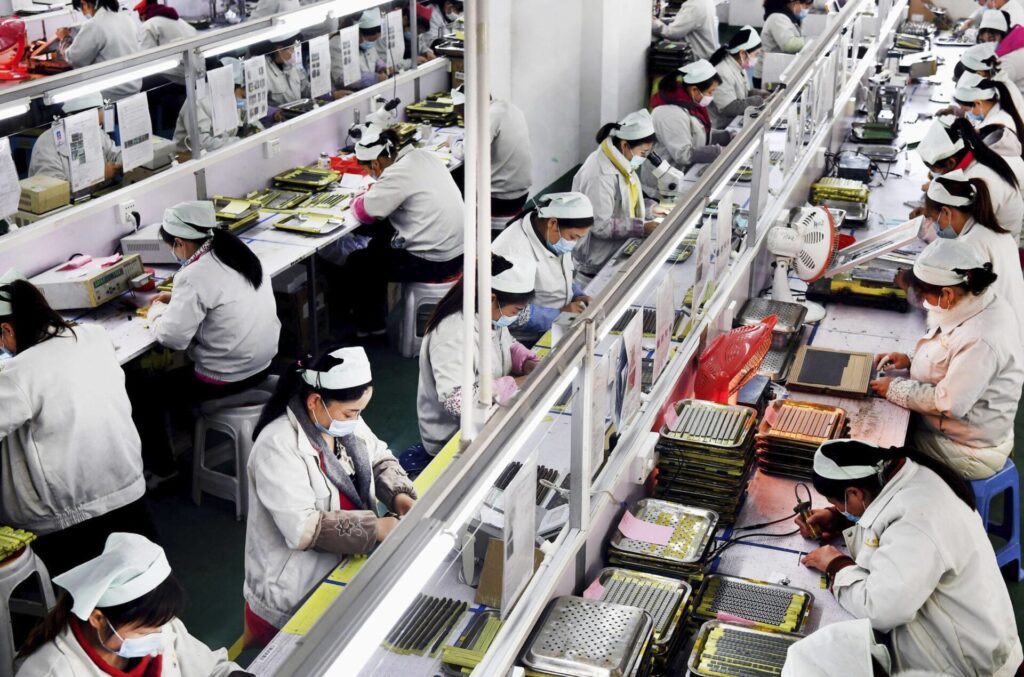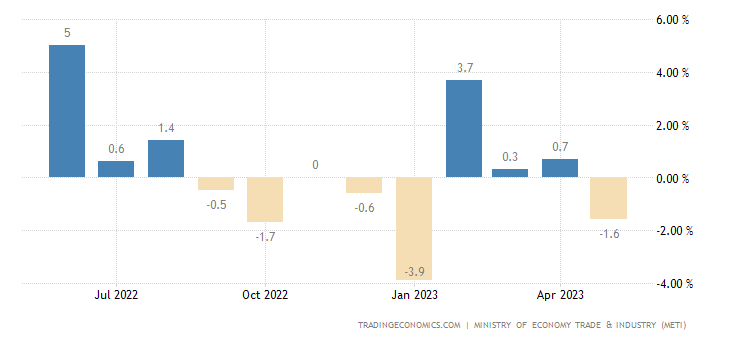Introduction:
In May 2023, Japan faced an unexpected setback in its industrial production. The numbers revealed Japan Industrial a decline of 1.6 percent compared to the previous month, marking the first drop since January. This outcome caught the market off guard, as it was worse than the anticipated 1.0 percent fall. Various factors played a role in this downturn, including a notable decrease in the output of motor vehicles, electrical machinery, information, and communication electronics equipment, as well as inorganic and organic chemicals.
Despite this temporary setback, there is a glimmer of hope. On an annual basis, Japan’s industrial output managed to bounce back. May witnessed a growth rate of 4.7 percent, recovering from the 0.7 percent fall experienced in April. This article aims to explore the intricacies of Japan’s industrial production landscape, delving into the underlying causes behind this decline and unraveling the potential implications for the overall economy. By doing so, we hope to shed light on the current challenges and potential future opportunities in Japan’s industrial sector.
Peeling Back the Layers: Japan Industrial
Let’s dive into the factors that played a crucial role in Japan’s recent slump in industrial production. One of the primary culprits was the significant drop in motor vehicle output. During May, the production of motor vehicles took a sharp nosedive, plummeting by a striking 8.9 percent. This decline stands in stark contrast to the promising 2.4 percent growth witnessed just a month earlier in April. To understand the reasons behind this setback, we need to explore a range of interconnected elements.

Firstly, supply chain disruptions wreaked havoc, causing a ripple effect throughout the industry. These disruptions, stemming from various sources, impeded the smooth flow of materials and components, hampering production processes. Additionally, reduced demand for vehicles also played a significant role in the decline. Changing consumer preferences, economic uncertainties, and shifting market dynamics all contributed to the subdued demand, ultimately impacting the output.
Beyond domestic factors, global economic conditions exerted their influence. The interconnectedness of the global economy meant that Japan’s industrial landscape couldn’t escape the repercussions of broader international trends. Fluctuating trade dynamics, geopolitical tensions, and evolving economic policies in major economies all had their part to play in shaping the environment in which Japan’s industrial sector operates.
Ramifications for the Japanese Economy:
The repercussions of the decline in industrial production in Japan Industrial extend far beyond the boundaries of the manufacturing sector. Given its significant contribution to the country’s GDP, any downturn in industrial output can trigger a domino effect across various sectors of the economy. The manufacturing industry, heavily reliant on robust industrial production, may encounter a host of challenges in the wake of this decline.
Firstly, reduced employment opportunities could emerge as a pressing concern. With industrial production dwindling, businesses might be compelled to scale back their workforce, leading to potential job losses and heightened uncertainty for workers. This, in turn, can have broader implications for household incomes, consumer spending, and overall economic stability.
Moreover, decreased investments could pose additional hurdles. A slump in industrial production may deter businesses from allocating resources toward expanding their operations or implementing innovative technologies. Such hesitance to invest can impede progress, hindering productivity gains and stifling the potential for future economic growth.

The Road to Recovery:
To revitalize industrial production, Japan needs to undertake targeted measures that address the challenges faced by key sectors. Firstly, it is essential to analyze the supply chain disruptions that affected the motor vehicle industry. Identifying and resolving bottlenecks in the supply chain, ensuring efficient logistics, and bolstering partnerships with suppliers can help restore stability and enhance output. Additionally, investing in research and development to innovate and upgrade manufacturing processes can improve the competitiveness of the electrical machinery and electronic equipment industries. Moreover, encouraging investments and providing incentives in the chemical industry can stimulate growth and counteract the decline observed in May.
The Global Economic Context: Japan Industrial
Japan’s industrial production declined in May 2023 cannot be seen in isolation but must be understood within the broader global economic context. Various factors, such as shifts in global demand patterns, trade tensions, and disruptions caused by the ongoing pandemic, have influenced the performance of economies worldwide. Therefore, it is essential to consider these external factors while formulating strategies to revive industrial production. Collaborating with international partners, diversifying export markets, and exploring new avenues for trade can help mitigate the impact of external shocks and enhance Japan’s resilience in the face of global economic uncertainties.

Investment Opportunities:
Despite the challenges posed by the decline in industrial production, there are potential investment opportunities for astute investors. The Japanese stock market, for instance, can present favorable prospects for those seeking long-term growth. Analyzing market trends and identifying companies within sectors poised for recovery, such as motor vehicle manufacturing, electrical machinery, and chemical production, can guide investment decisions. Additionally, investors can explore opportunities in research and development initiatives, especially in areas such as clean energy, artificial intelligence, and automation, which are key drivers of future industrial growth. By strategically diversifying portfolios and capitalizing on these opportunities, investors can position themselves to benefit from Japan’s eventual rebound.
Conclusion:
May 2023 witnessed a decline in Japan’s industrial production, marking the first drop since January. Factors such as reduced motor vehicle output, lower production in electrical machinery and electronic equipment, and a decline in chemical production contributed to this setback. However, the annual growth rate of 4.7 percent in May indicates signs of recovery and resilience. To navigate these challenging times, Japan must focus on revitalizing its industrial production through targeted measures, while considering the global economic context. By seizing investment opportunities in sectors primed for recovery, investors can align their strategies with Japan’s future growth trajectory. Ultimately, with proactive measures and strategic planning, Japan can overcome the current downturn and restore its industrial prowess on the global stage.






mexican drugstore online: online mexican pharmacy – mexican online pharmacies prescription drugs
medicine in mexico pharmacies: best online pharmacies in mexico – mexican rx online
http://foruspharma.com/# buying prescription drugs in mexico
canada discount pharmacy: canadianpharmacy com – canada rx pharmacy world
http://foruspharma.com/# mexican rx online
canadian medications legitimate canadian online pharmacies canadian neighbor pharmacy
cheapest online pharmacy india cheapest online pharmacy india indian pharmacies safe
buying prescription drugs in mexico online: mexican pharmacy – buying from online mexican pharmacy
canadian pharmacy sarasota: cross border pharmacy canada – pharmacies in canada that ship to the us
https://foruspharma.com/# mexican rx online
п»їbest mexican online pharmacies best online pharmacies in mexico mexican border pharmacies shipping to usa
canadian drug pharmacy: canadian pharmacy in canada – canadian pharmacy online reviews
certified canadian pharmacy: best canadian pharmacy online – legit canadian pharmacy
buy prescription drugs from india: reputable indian pharmacies – online pharmacy india
online pharmacy india indian pharmacies safe top 10 online pharmacy in india
https://canadapharmast.online/# reliable canadian pharmacy
mexican pharmacy: mexico drug stores pharmacies – mexican border pharmacies shipping to usa
medicine in mexico pharmacies: mexican online pharmacies prescription drugs – best online pharmacies in mexico
http://foruspharma.com/# medication from mexico pharmacy
buying prescription drugs in mexico online mexican pharmacy mexican mail order pharmacies
mexican border pharmacies shipping to usa: п»їbest mexican online pharmacies – mexican mail order pharmacies
buying from online mexican pharmacy: medicine in mexico pharmacies – mexican pharmaceuticals online
reputable mexican pharmacies online: mexican drugstore online – best online pharmacies in mexico
https://indiapharmast.com/# indian pharmacies safe
medicine in mexico pharmacies п»їbest mexican online pharmacies reputable mexican pharmacies online
doxycycline canada pharmacy: can you buy doxycycline over the counter in nz – doxycycline 75 mg capsules
http://ciprodelivery.pro/# ciprofloxacin order online
buy doxycycline 100mg online: doxycycline hydrochloride 100mg – doxycycline cheap australia
https://clomiddelivery.pro/# where to get cheap clomid price
http://ciprodelivery.pro/# buy cipro online without prescription
amoxicillin 500mg no prescription amoxicillin medicine over the counter amoxacillian without a percription
buy amoxicillin canada: where to buy amoxicillin pharmacy – amoxicillin without rx
https://ciprodelivery.pro/# cipro ciprofloxacin
https://paxloviddelivery.pro/# paxlovid india
http://paxloviddelivery.pro/# paxlovid for sale
doxycycline without a prescription doxycycline 100 doxycycline 100mg capsules price
how to get generic clomid online: get cheap clomid price – where to get cheap clomid
https://doxycyclinedelivery.pro/# doxycycline 10mg cost
https://ciprodelivery.pro/# buy cipro
http://ciprodelivery.pro/# cipro online no prescription in the usa
cheap amoxicillin 500mg amoxicillin medicine amoxicillin 500 capsule
https://ciprodelivery.pro/# ciprofloxacin
can you get generic clomid without dr prescription: can i get clomid no prescription – where can i buy clomid
http://doxycyclinedelivery.pro/# can you buy doxycycline over the counter in nz
http://doxycyclinedelivery.pro/# order doxycycline online canada
buying generic clomid price can i order cheap clomid without rx can you buy clomid for sale
https://doxycyclinedelivery.pro/# buy doxycycline online nz
doxyciclin: buy doxycycline 100mg canada – can you buy doxycycline over the counter canada
http://doxycyclinedelivery.pro/# doxycycline 75 mg coupon